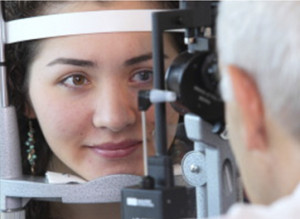
At a time when more people turn to the internet for everything, from information to shopping to making a living, it is not surprising that telemedicine has become more of a reality each day. Now, psychiatric patients can have Skype therapy sessions from the comfort of home, monthly medication prescriptions can be refilled with the click of a mouse, and even an eye exam can be performed with just a laptop and a smartphone. But for all the convenience and efficiency that telecommunication and information technology has brought to our lives, how well can it replace the thoroughness and expertise of a doctor’s appointment?
What do online eye exam companies promise?
One online company in particular, Opternative, has come under scrutiny recently for claiming to offer refractive eye exams that are just as accurate as an in-person exam with an optometrist. Needless to say, the claim drew the attention of the American Optometric Association (AOA), an organization that represents nearly 40,000 optometrists, optometry students, and paraoptometric technicians and assistants, as well as the American Academy of Ophthalmology (AAO), the largest national membership association of ophthalmologists, osteopathic doctors, and medical doctors in the country.
According to Opternative, in order to take the online refractive eye exam, a patient needs to be between the ages of 18 and 40 and have access to a computer and a smartphone. Following a series of online visual tests and multiple choice questions, the patient’s results are then sent to a physician to approve or deny the patient’s glasses or contact lens prescriptions within at least 24 hours. Based on Opternative’s own clinical study, the results of the online refractive test are just as accurate as a traditional exam and only use technology that has already been approved by the U.S. Food and Drug Administration.
Both the AOA and AAO have openly challenged the online company, stating that Opternative’s claims are misleading to consumers because they highlight convenience, low costs, and FDA approval without providing adequate information about the limitations of the test.
Important factors to consider when taking an online vision test
In order to help the public more accurately evaluate online eye exams, the AAO has issued the following guidelines.
- First, an online test is not a substitute for a one-on-one eye exam. It may be used as a follow-up tool for patients between the ages of 18 and 39 who do not need severe corrective eyeglasses.
- If you experience vision problems, schedule an appointment with an ophthalmologist.
- Patients under 18 years of age or 40 and older should not rely on online eye exams. Instead, they should visit a qualified ophthalmologist or optometrist who can identify risk factors or symptoms of eye disease and begin treatment as soon as possible.
- Patients between the ages of 18 and 39 should schedule comprehensive eye exams every five to 10 years to detect eye diseases and conditions such as glaucoma, cataracts, or corneal astigmatism that may not present immediate symptoms.
- Online vision tests cannot offer accurate prescriptions for patients that need irregular or high-power prescriptions.
- Online vision tests can test the power of eyeglass prescriptions, but are not effective at testing contact lens prescriptions.
Schedule an eye Exam at USC Roski Eye Institute
Regular, annual eye exams from a professional optometrist or ophthalmologist are the only way to accurately catch vision problems and get effective treatment. An online eye exam may be appealing for its convenience, but it is important that patients are fully aware of the limitations.
To make an appointment at the USC Roski Eye Institute, please call (323) 442-6335 or contact us to schedule a consultation today.
Topics
